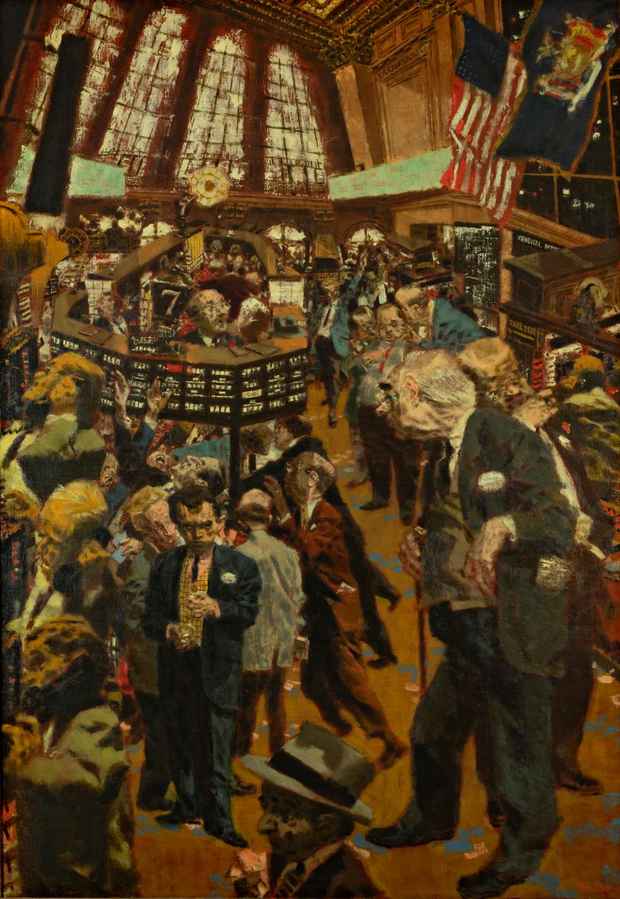Frank Robbins “The Prodigy”
Shin Gallery (66-68 Orchard St.)

[Image: Frank Robbins "The Big Board" (1955) Oil on canvas 46 x 32 in. ]
This event has ended.
Shin Gallery presents an exhibition of paintings by the American artist and famed comic writer and illustrator Frank Robbins (1917-1994). Though beloved by many for his contributions to popular Marvel Comics and DC Comics issues in the 1970s, Robbins’ lesser-known body of work features a diverse collection of stylized social-realist paintings depicting scenes of bullfights, burlesque clubs and social life in both New York City and San Miguel de Allende, Mexico where he retired in 1978. His brushwork evokes the frenzied energy of Francis Bacon’s portraits and Henri Toulouse-Lautrec’s Moulin Rouge scenes, with urban subjects not unlike characters from a Norman Rockwell illustration. Robbins’ dedication to studying the techniques of Old Masters as a child lends an Italian influence in his color palette and textures: the draftsmanship of Leonardo da Vinci in the anatomical precision of bodies in motion, as well as the dramatic Caravaggio-esque chiaroscuro. This exhibition of representational abstract works celebrates Robbins’ painterly skill and discerning eye for capturing the vivid rapture of the human experience.
Born to a single mother in Boston, Robbins grew up as a self-professed “latchkey kid,” spending much of his early childhood alone making art. A young prodigy, he began drawing on egg cartons at the age of three. Robbins spent most of his adolescent years poring over anatomy textbooks to study the physiology of the human body, also devoting his attention to da Vinci’s drawings as well as the engravings of Albrecht Durer and the etchings of Francisco Goya.
At nine years old, he was awarded a scholarship to pursue classes at the Boston Museum of Fine Arts. He continued studying art under scholarships until departing for New York in 1932, where he was awarded the Rockefeller Grant. Robbins resumed his studies at the National Academy of Design all while executing a series of commissioned portraits of the leading architects of Radio City and designing set murals for the Children’s Studio at NBC.
At the age of 18, his first entry in a national group show won him the Thomas B. Clarke Award for Best American Figure Composition. He was the youngest individual to ever win. In 1935, Robbins began his career in newspaper comic strips, also illustrating for the Saturday Evening Post and Look magazines. His Sunday strips were visible on the front comic page of The New York Post. Robbins painted largely for leisure, finding solace in his practice as a form of escapism from the expeditious life of a commercial artist. He drew inspiration from the works of illustrator Howard Pyle and muralist Edward Trumbull, the latter of whom acted as a mentor to the young Robbins when he first arrived in New York.
As a comic artist, he is best known for creating the aviation adventure strip Johnny Hazard (1944- 1977), as well as illustrating and writing for several comic book series including Batman, Superboy, and Captain America. Robbins’ acute attention to detail allowed his comic characters to be unusually dynamic in their posturing, a technique that was at odds with the traditional standand- pose style of cartoon illustration. Though his unconventional drawing style at times drew criticism from fellow cartoonists, his mastery of shading and contrast translated exceedingly well into his painting.
During his life, Robbins held solo exhibitions at the Little Studio on Madison Avenue in 1961 and Blondelle Gallery in 1964. For his cartooning talents, he won the esteemed Reuben Award for Outstanding Cartoonist of the Year in 1970. Robbins also exhibited at several landmark institutions including the Whitney Museum of American Art, New York, The Metropolitan Museum of Art, New York, Corcoran Gallery, Washington D.C., and Walker Art Gallery, Minneapolis.
Robbins’ artistic process was strategic and well-organized; he made numerous preliminary sketches of potential compositions before ever putting a brush to canvas. This practice of discovering compositional balance directly correlates to his cartoon work. The decades he spent meticulously positioning letters and imagery together on small strips is ultimately conveyed in his paintings. Robbins’ figures fill the entire field of vision and usually reflect a narrative of some kind, a technique likely formed from his experience with the space restrictions of comic strips.
The Big Board (1955), for example, depicts a scene of the trading floor at the New York Stock Exchange. Robbins carefully takes into consideration the size of the individuals, color coordination and orientation, all necessary components to address commentary and a vanishing point perspective for the viewer. The room is chaotic—cash is flowing out of pockets and whiskey is being drunk on the center of the floor. In this work, Robbins takes a Jack Levine-like approach in his critique of the corruption of the financial industry and their egregious pursuit of money and power. Though he painted scenes of social life in an urban public, the closely cropped framing of subjects and their chromatic sensuality create an unusually intimate view of the absurd little world that is New York.
Media
Schedule
from May 26, 2021 to June 04, 2021